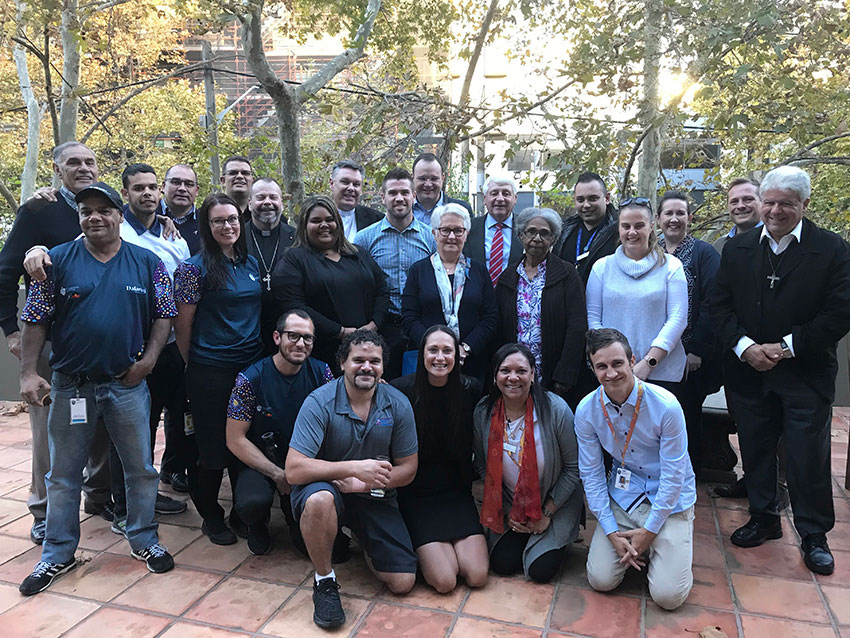Bishops get insights into Indigenous health program

A delegation of bishops has toured a Sydney Catholic hospital that is improving the health of Indigenous people via a range of innovative reconciliation and Closing the Gap programs.
Members of the Bishops Commission for Relations with Aboriginal and Torres Strait Islander Peoples and the National Aboriginal and Torres Strait Islander Catholic Council (NATSICC) recently visited St Vincent’s Hospital in Darlinghurst.
Commission chairman Bishop Columba-Macbeth Green OSPPE said the group was impressed by the concrete ways the hospital is supporting Aboriginal health, education and employment opportunities.
“It is heartening to see a program that works with Indigenous individuals in their pursuit of a better life, not only for themselves but also for their brothers and sisters in their local communities,” Bishop Macbeth-Green said.
“Some of the personal stories that were told were truly inspirational … stories not only of failure, but of hard work and success in so many individual and unique ways.”
Townsville Bishop Tim Harris and Darwin Bishop Charles Gauci also represented the Bishops Commission during the joint visit with NATSICC.
Pauline Deweerd, director of the Aboriginal Health Unit at St Vincent’s, said the hospital has made a concerted effort in the past 10 years to meet Closing the Gap targets via the hospital’s Reconciliation Action Plan.
The plan specifically targets Aboriginal and Torres Strait Islander life expectancy, education and employment outcomes, as well as partnership agreements with Aboriginal community organisations.
“We have gone from having just four Aboriginal staff members in 2010 to now having 74 Indigenous people employed in a variety of roles right across the hospital,” Ms Deweerd said.
In addition to acknowledgement plaques and Aboriginal art being prominently displayed throughout the hospital, a key platform of reconciliation efforts was the highly successful “Respecting the Difference” training program, she said.
“Our hospital staff have received ‘Respecting the Difference’ training to ensure that all of our Aboriginal and Torres Strait Islander patients and guests are welcomed to a culturally respectful environment,” Ms Deweerd explained.
Nearly 90 per cent of staff at the hospital had undertaken a two-hour Indigenous training program, while 50 per cent had completed a full day of training in cultural awareness, specifically targeting practical skills for dealing with Aboriginal patients.
“People are allowing Aboriginal people to have a voice in this organisation,” Ms Deweerd said.
Bishop Macbeth-Green said the gap in life expectancy between Aboriginal and Torres Strait Islander people and non-Indigenous people, especially those in remote and regional areas, was of great concern.
According to the Australian Bureau of Statistics, at all ages for both males and females, life expectancy for Aboriginal and Torres Strait Islander Australians is significantly lower than for non-Indigenous Australians.
For Aboriginal and Torres Strait Islander males born between 2015 and 2017, their life expectancy of 71.6 year was more than eight years shorter than a non-Indigenous baby boy. For women, the difference was almost eight years.
“We need to remember the words of Pope St John Paul II who told Australia’s first peoples that: ‘You are part of Australia and Australia is part of you. And the Church herself in Australia will not be fully the Church that Jesus wants her to be until you have made your contribution to her life and until that contribution has been joyfully received by others’,” Bishop Macbeth-Green said.
National Reconciliation Week was celebrated throughout Australia last week, with this year’s theme “Grounded in Truth Walk Together with Courage”.
“Let us pray for guidance as we continue to work in these concrete way to support the reconciliation process,” Bishop Macbeth-Green said.
Source: ACBC Communications


